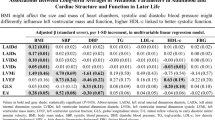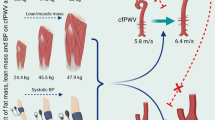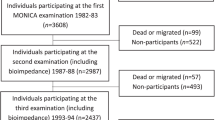Abstract
Introduction:
Although lipid profiles tend to worsen with age, it is not fully known if such age-related changes are influenced primarily by body composition and lifestyle or by other aspects of aging.
Objective:
We investigated the extent to which the fat and fat-free components of body mass index (BMI) and lifestyle factors influence patterns of change in lipids independent of age.
Design:
Serial data were analyzed using sex-specific longitudinal models. These models use serial data from individuals to assume a general pattern of change over time, while allowing baseline age and the rate of change to vary among individuals.
Subjects:
Serial data were obtained from 940 examinations of 269 healthy white participants (126 men, 143 women), aged 40–60 years, in the Fels Longitudinal Study.
Measurements:
Measurements included age, the fat (FMI) and fat-free mass (FFMI) components of BMI, high-density lipoprotein (HDL-C), low-density lipoprotein (LDL-C), triglycerides (TG), total cholesterol (TC), fasting glucose and insulin, physical activity, alcohol use and smoking, and women's menopausal status and estrogen use.
Results:
In both sexes, increased FMI was significantly associated with increased LDL-C, TG and TC, and decreased HDL-C. Increased FFMI was significantly related to decreased HDL-C and increased TG. Independent age effects remained significant only for LDL-C and TC in men and TC in women. Increased insulin was significantly related to increased TG in women. Moderate alcohol consumption was associated with higher HDL-C in men. Physical activity lowered male LDL-C and TC levels, and increased female HDL-C levels. Menopause was associated with increases in LDL-C. Premenopausal women not using estrogen had significantly lower HDL-C, TG, and TC than postmenopausal women taking estrogen.
Conclusions:
(1) Age is an important independent predictor for LDL-C and TC in men, and TC in women, but it is not as influential as body composition and lifestyle on HDL-C and TG in men and women, and LDL-C in women. (2) Increasing FMI is the major contributor to elevated TC, LDL-C and TG levels, and decreased HDL-C levels in men and women. (3) FFMI significantly influences HDL and TG levels in both sexes. (4) Maintaining a lower BMI via a reduced fat component may be more beneficial in lowering CVD risks than other factors.
This is a preview of subscription content, access via your institution
Access options
Subscribe to this journal
Receive 12 print issues and online access
$259.00 per year
only $21.58 per issue
Buy this article
- Purchase on Springer Link
- Instant access to full article PDF
Prices may be subject to local taxes which are calculated during checkout

Similar content being viewed by others
References
Heitmann BL . The effects of gender and age on associations between blood lipid levels and obesity in Danish men and women aged 35–65 years. J Clin Epidemiol 1992; 45: 693–702.
Schaefer EJ, Lamon-Fava S, Cohn SD, Schaefer MM, Ordovas JM, Castelli WP et al. Effects of age, gender, and menopausal status on plasma low density lipoprotein cholesterol and apolipoprotein B levels in the Framingham Offspring Study. J Lipid Res 1994; 35: 779–792.
Abraham S, Johnson C, Carroll M Total serum cholesterol levels of adults 18–74 Years, United States, 1971–1974: Washington, D.C.: National Center for Health Statistics, Vital And Health Statistics Vital and Health Statistics: Series 11, No. 205, 1978; 1–31.
Carroll M, Sempos C, Briefel R, Gray S, Johnson C . Serum Lipids of Adults 20–74 years: United States 1976–1980. National Center for Health Statistics: Washington, DC, 1993; 1–107.
Rubins HB, Robins SJ, Collins D, Iranmanesh A, Wilt TJ, Mann D et al. Distribution of lipids in 8500 men with coronary artery disease. Am J Cardiol 1995; 75: 1196–1201.
Siervogel RM, Wisemandle W, Maynard LM, Guo SS, Roche AF, Chumlea WC et al. Serial changes in body composition throughout adulthood and their relationships to changes in lipid and lipoprotein levels. The Fels Longitudinal Study. Arterioscl ThrombVas Biol 1998; 18: 1759–1764.
Weijenberg MP, Feskens EJM, Kromhout D . Age-related changes in total and high-density-lipoprotein cholesterol in elderly Dutch men. Am J Public Health 1996; 86: 798–803.
Eaton CB, Lapane KL, Garber CE, Assaf AR, Lasater TM, Carleton RA . Physical activity, physical fitness, and coronary heart disease risk factors. Med Sci Sports Exer 1995; 27: 340–346.
Brownell KD, Bachorik PS, Ayerle RS . Changes in plasma lipid and lipoprotein levels in men and women after a program of moderate exercise. Circulation 1982; 65: 477–484.
Whitehead TP, Robinson D, Allaway SL . The effects of cigarette smoking and alcohol consumption on blood lipids: A dose-related study on men. Ann Clin Biochem 1996; 33: 99–106.
Torng P, Su T, Sung FC, Chien K, Huang S, Chow S et al. Effects of menopause on intraindividual changes in serum lipids, blood pressure, and body weight – the Chin-Shan community cardiovascular cohort study. Atherosclerosis 2002; 161: 409–415.
Peters HW, Westendorp ICD, Hak AE, Grobbee DE, Stehouwer CDA, Hofman A et al. Menopausal status and risk factors for cardiovascular disease. J Int Med 1999; 246: 521–528.
Stevenson JC, Crook D, Godsland IF . Influence of age and menopause on serum lipids and lipoproteins in healthy women. Atherosclerosis 1993; 98: 83–90.
Kim CJ, Kim TH, Ryu WS, Ryoo UH . Influence of menopause on high density lipoprotein-cholesterol and lipids. J Korean Med Sci 2000; 15: 380–386.
Sattar N, Tan CE, Han TS, Forster L, Lean ME, Shepherd J et al. Associations of indices of adiposity with atherogenic lipoprotein subfractions. Int J Obes 1998; 22: 432–439.
Ramirez ME, Hunt SC, Williams RR . Blood pressure and blood lipids in relation to body size in hypertensive and normotensive adults. Int J Obes 1991; 15: 127–145.
Walton C, Lees B, Crook D, Godsland IF, Stevenson JC . Relationships between insulin metabolism, serum lipid profile, body fat distribution and blood pressure in healthy men. Atherosclerosis 1995; 118: 35–43.
Smith SR, Lovejoy JC, Greenway F, Ryan D, deJonge L, de lB J et al. Contributions of total body fat, abdominal subcutaneous adipose tissue compartments, and visceral adipose tissue to the metabolic complications of obesity. Metab Clin Exp 2001; 50 (April): 425–435.
Nagaya T, Yoshida H, Takahashi H, Matsuda Y, Kawai M . Body mass index (weight/height2) or percentage body fat by bioelectrical impedance analysis: which variable better reflects serum lipid profile? Int J Obes 1999; 23: 771–774.
Ferrara A, Barrett-Connor E, Shan J . Total, LDL, and HDL cholesterol decrease with age in older men and women. The Rancho Bernardo Study 1984–1994. Circulation 1997; 96: 37–43.
Eberle E, Doering A, Keil U . Weight change and change of total cholesterol and high-density-lipoprotein cholesterol. Results of the MONICA Augsburg cohort study. Ann Epidemiol 1991; 1: 487–492.
Folsom AR, Li Y, Rao X, Cen R, Zhang K, Liu X et al. Body mass, fat distribution and cardiovascular risk factors in a lean population of south China. J Clin Epidemiol 1994; 47: 173–181.
VanItallie TB, Yang M, Heymsfield SB, Funk RC, Boileau RA . Height-normalized indices of the body's fat-free mass and fat mass: potentially useful indicators of nutritional status. Am J Clin Nutr 1990; 52: 953–959.
Kyle UG, Schutz Y, Duptertuis YM, Pichard C . Body composition interpretation: contributions of the fat-free mass index and the body fat mass index. Nutrition 2003; 19: 597–604.
Schutz Y, Kyle UGG, Pichard C . Fat-free mass index and fat mass index percentiles in Caucasians aged 18–98 y. Int J Obes 2002; 26: 953–960.
Roche AF . Growth, Maturation, and Body Composition: The Fels Longitudinal Study, 1929–1991. Cambridge University Press: Cambridge, UK, 1991.
Lohman T, Martorell R, Roche AF . Anthropometric Standardization Reference Manual. Human Kinetics: Champaign, IL, 1988.
Guo SM, Roche AF, Houtkooper L . Fat-free mass in children and young adults predicted from bioelectric impedance and anthropometric variables. Am J Clin Nutr 1989; 50: 435–443.
Department of Health E, and Welfare. Lipid Research Clinics Program: Manual of Laboratory Operations vol. 1. U.S. Government Printing Office: Washington, DC, 1994.
Baecke JA, Burema J, Frijters JE . A short questionnaire for the measurement of habitual physical activity in epidemiological studies. Am J Clin Nutr 1982; 36: 936–942.
Philippaerts RM, Westerterp KR, Lefevre J . Doubly labelled water validation of three physical activity questionnaires. Int J Sports Med 1999; 20: 284–289.
Pols MA, Peeters PH, Bueno-De-Mesquita HB, Ocke MC, Wentink CA, Kemper HC et al. Validity and repeatability of a modified Baecke questionnaire on physical activity. Int J Epidemiol 1995; 24: 381–388.
Jacobs DRJ, Ainsworth BE, Hartman TJ, Leon AS . A simultaneous evaluation of 10 commonly used physical activity questionnaires. Med Sci Sports Exer 1993; 25: 81–91.
Laird NM, Ware JH . Random-effects models for longitudinal data. Biometrics 1982; 38: 963–974.
Chi E, Reinsel G . Models for longitudinal data with random effects and AR(1) errors. J Am Stat Assoc 1989; 84: 452–459.
SAS. SAS User's Guide: Statistics. North Carolina, 1999.
American Diabetes Association. Diagnosis and classification of diabetes mellitus. Diabetes Care 2005; 28 (Suppl 1): S37–S42.
Allison DB, Faith MS, Heo M, Townsend-Butterworth D, Williamson DF . Meta-analysis of the effect of excluding early deaths on the estimated relationship between body mass index and mortality. Obes Res 1999; 7: 342–354.
Troiano RP, Frongillo EAJ, Sobal J, Levitsky DA . The relationship between body weight and mortality: a quantitative analysis of combined information from existing studies. Int J Obes 1996; 20: 63–75.
Guo SS, Zeller C, Chumlea WC, Siervogel RM . Aging, body composition, and lifestyle: the Fels Longitudinal Study. Am J Clin Nutr 1999; 70: 405–411.
Pyorala T . The effect of synthetic estrogens on glucose tolerance, plasma insulin and lipid metabolism in postmenopausal women. In: Campbell S (ed). The Management of the Menopause and Post-Menopausal Years. MTP Press: Lancaster, 1979. pp 195–210.
Wallentin L, Larsson-Cohn U . Metabolic and hormonal effects of post-menopausal oestrogen replacement treatment. Acta Endocrinol 1977; 86: 597–607.
Knopp RH, Walden CE, Wahl PW, Hoover JJ, Warnick GR, Albers JJ et al. Oral contraceptive and postmenopausal estrogen effects on lipoprotein triglyceride and cholesterol in an adult female population: relationships to estrogen and progestin potency. J Clin Endocrinol Metab 1981; 53: 1123–1132.
Bradley DD, Wingerd J, Petitti DB, Krauss RM, Ramcharan S . Serum high-density-lipoprotein cholesterol in women using oral contraceptives, estrogens and progestins. N Engl J Med 1978; 299: 17–20.
Pietrobelli A, Lee RC, Capristo E, Deckelbaum RJ, Heymsfield SB . An independent, inverse association of high-density-lipoprotein-cholesterol concentration with nonadipose body mass. Am J Clin Nutr 1999; 69: 614–620.
Berg A, Ringwald G, Keul J . Lipoprotein-cholesterol in well-trained athletes: a preliminary communication: reduced HDL-cholesterol in power athletes. Int J Sports Med 1980; 1: 137–138.
Clarkson PM, Hintermister R, Fillyaw M, Stylos L . High density lipoprotein cholesterol in young adult weight lifters, runners and untrained subjects. Hum Biol Int Rec Res 1981; 53: 251–257.
Farrell PA, Maksud MG, Pollock ML, Foster C, Anholm J, Hare J et al. A comparison of plasma cholesterol, triglycerides, and high density lipoprotein-cholesterol in speed skaters, weightlifters and non-athletes. Eur J Appl Physiol Occup Physiol 1982; 48: 77–82.
West SG, Hilpert KF, Juturu V, Bordi PL, Lampe JW, Mousa SA et al. Effects of including soy protein in a blood cholesterol-lowering diet on markers of cardiac risk in men and in postmenopausal women with and without hormone replacement therapy. J Womens Health (Larchmt) 2005; 14: 253–262.
Cook Z . Diet will help reduce cholesterol levels. Prof Nurs 2005; 20: 44.
Weltman A, Despres JP, Clasey JL, Weltman JY, Wideman L, Kanaley J et al. Impact of abdominal visceral fat, growth hormone, fitness, and insulin on lipids and lipoproteins in older adults. Metab: Clin Exp 2003; 52: 73–80.
Acknowledgements
This work was supported by Grant AHA 0110144B from the American Heart Association Ohio Valley Affiliate, and Grants HL 072838, DK 71485, and HD12252 from the National Institutes of Health, Bethesda, MD, USA.
Author information
Authors and Affiliations
Corresponding author
Rights and permissions
About this article
Cite this article
Schubert, C., Rogers, N., Remsberg, K. et al. Lipids, lipoproteins, lifestyle, adiposity and fat-free mass during middle age: the Fels Longitudinal Study. Int J Obes 30, 251–260 (2006). https://doi.org/10.1038/sj.ijo.0803129
Received:
Revised:
Accepted:
Published:
Issue Date:
DOI: https://doi.org/10.1038/sj.ijo.0803129
Keywords
This article is cited by
-
Methodological challenges in studies of the role of blood lipids variability in the incidence of cardiovascular disease
Lipids in Health and Disease (2021)
-
Multi-trajectories of lipid indices with incident cardiovascular disease, heart failure, and all-cause mortality: 23 years follow-up of two US cohort studies
Journal of Translational Medicine (2021)
-
Modeling the risk factors for dyslipidemia and blood lipid indices: Ravansar cohort study
Lipids in Health and Disease (2020)
-
Evaluation of eight formulas for LDL-C estimation in Iranian subjects with different metabolic health statuses
Lipids in Health and Disease (2019)
-
XX sex chromosome complement promotes atherosclerosis in mice
Nature Communications (2019)



